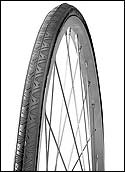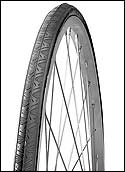A lot depends on how much weight you’re carrying on the bike. And, what kind of roads you’ll be on. With less weight, and good roads ahead, you can ride a thinner tire for less rolling resistance and lower spinning weight. Some people tour on tires as thin as 700×25, but I think that’s a bit extreme. (Worth noting to newbie bikers here that this sequence of numbers equates to tire diameter and rubber width in millimeters, respectively.)
 Conti Grand Prix Tire
Conti Grand Prix Tire
It’s not just weight and rolling resistance that are importanta fatter tire rides more comfortably (a good thing when spending long days in the saddle) and is more resistant to flats, particularly “snakebite” flats that occur when you hit a sharp edge such as a curb and the tire deforms, catching the tube between itself and the rim. So I’d say a minimum size for a touring tire that offers a good combination of performance and comfort is 700×28. Continental makes an excellent tire called the Grand Prix 4-Season ($51; www.conti-online.com) that’s available in that size.
I prefer to go even more relaxed than that. On my touring bikea Bob Jackson Special TouristI run another Continental tire, the Top Touring, that is 700×32. That’s a pretty fat tire. But I like the Top Tourings because they ride comfortably, have a fairly aggressive (but smooth-rolling) tread for good traction and braking, and are very nearly immune to flats. They’ve also got plenty of “float” for that odd patch of gravel road. They roll fineI’m not breaking any speed limits when I’m touring. They’re available from Bike Nashbar and other bike stores for $45 a pop (www.nashbar.com).
Have a great ride. That should be quite some trip, with or without any maintenance pit stops.
For more must-have road-touring gear, read in ���ϳԹ���‘s 2004 Buyer’s Guide.


